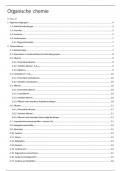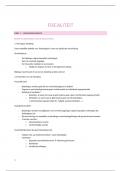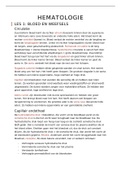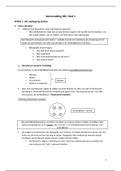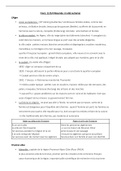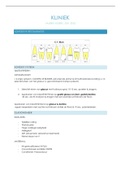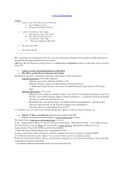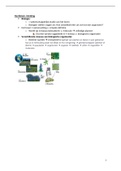Inhoud
1. Algemene begrippen ......................................................................................................................................... 4
1.1. Koolstofverbindingen.................................................................................................................................. 4
1.2. Formules.................................................................................................................................................... 5
1.3. Isomeren ................................................................................................................................................... 5
1.4. Conformeren.............................................................................................................................................. 7
1.4.1. Ringconformaties ................................................................................................................................. 7
2. Nomenclatuur.................................................................................................................................................. 7
2.1. Basisprincipes ............................................................................................................................................ 7
2.2. Stamnamen + karakteristieke (functionele) groepen ..................................................................................... 8
2.3. Alkanen ..................................................................................................................................................... 9
2.3.1. Onvertakte alkanen .............................................................................................................................. 9
2.3.2. Vertakte alkanen: CnH2n+2 ...................................................................................................................... 9
2.3.3. Zijketens .............................................................................................................................................. 9
2.4. Cycloalkanen: CnH2n .................................................................................................................................. 10
2.4.1. Onvertakte cycloalkanen..................................................................................................................... 10
2.4.2. Vertakte cycloalkanen......................................................................................................................... 10
2.5. Alkenen ................................................................................................................................................... 10
2.5.1. Onvertakte alkenen ............................................................................................................................ 10
2.5.2. Cycloalkenen...................................................................................................................................... 10
2.5.3. Vertakte alkenen ................................................................................................................................ 10
2.5.4. Alkenen met meerdere dubbele bindingen .......................................................................................... 10
2.6. Alkynen.................................................................................................................................................... 11
2.6.1. Onvertakte alkynen ............................................................................................................................ 11
2.6.2. Vertakte alkynen ................................................................................................................................ 11
2.6.3. Alkynen met meerdere drievoudige bindingen ..................................................................................... 11
2.7. Aromatische koolwaterstoffen = arenen (Ar) .............................................................................................. 11
2.8. Halogeenwaterstoffen............................................................................................................................... 12
2.9. Alcoholen................................................................................................................................................. 12
2.10. Fenolen.................................................................................................................................................. 12
2.11. Ethers .................................................................................................................................................... 13
2.12. Aldehyden.............................................................................................................................................. 13
2.13. Ketonen ................................................................................................................................................. 14
2.14. Carbonzuren .......................................................................................................................................... 14
2.15. Organische zuurrestionen........................................................................................................................ 15
2.16. Carbonzuurhalogeniden .......................................................................................................................... 15
2.17. Carbonzuuranhydriden ........................................................................................................................... 16
, 2.18. Carbonzuuresters ................................................................................................................................... 16
2.19. Carbonzuuramiden ................................................................................................................................. 17
2.20. Aminen .................................................................................................................................................. 17
2.21. Nitrillen.................................................................................................................................................. 17
3. Intermoleculaire krachten................................................................................................................................ 18
3.1. (A)polaire atoombindingen ....................................................................................................................... 18
3.2. Polaire en apolaire moleculen ................................................................................................................... 19
3.3. Belangrijke soorten intermoleculaire krachten ........................................................................................... 19
Geïnduceerd dipool – geïnduceerd dipoolinteracties: (apolair & apolair) ................................................. 19
Dipool - geïnduceerde dipoolinteracties: (apolair & polair) .................................................................... 19
Dipool-dipoolinteracties: (polair & polair) ........................................................................................... 20
Ion- dipoolinteracties: (polair & ion) ................................................................................................... 20
Ion-ioninteracties (ion & ion) ............................................................................................................ 20
4. Zuren en basen ............................................................................................................................................... 22
4.1. Bronsted-Lowry theorie ............................................................................................................................ 22
4.2. Zuur en base constante............................................................................................................................. 22
4.3. Organische functies en zuur gedrag in water .............................................................................................. 23
4.4. Factoren die zuur gedrag beïnvloeden ....................................................................................................... 24
4.4.1. Inleiding tot mesomerie...................................................................................................................... 26
4.5. Karakteristieke pKa-waarden ..................................................................................................................... 27
4.6. Henderson-Hasselbalch vergelijking........................................................................................................... 27
5. Organische reacties ......................................................................................................................................... 28
5.1. Indeling op basis van bindingsdoorbraak.................................................................................................... 28
5.2. Indeling op basis van aanvallend deeltje .................................................................................................... 28
5.3. Indeling op basis van reactietype............................................................................................................... 29
6. Reactiemechanismen van enkele organische verbindingsklassen........................................................................ 34
6.1. Nucleofiele substantiereacties S n ............................................................................................................... 34
SN met halogeenalkanen .............................................................................................................................. 34
Reactiekinetiek............................................................................................................................................ 34
Snelheidsbepalende factoren ....................................................................................................................... 35
6.2. Nucleofiele additie-eliminatie reacties van carbonzuur(derivaten) S A+E ......................................................... 40
Reactiesnelheid ........................................................................................................................................... 40
Activering carbonzuur in de cel (veel tekst, fluoresceren) ...................................................................... 41
6.3. Eliminatiereacties E1, E2 ............................................................................................................................. 41
Dehydrogenatie........................................................................................................................................... 41
Dehydratatie ............................................................................................................................................... 42
Alcoholcondensatie ..................................................................................................................................... 42
6.4. Elektrofiele additiereacties, A E ................................................................................................................... 43
6.5. Nucleofiele additiereacties, AN .................................................................................................................. 44
, Reductie carbonyl met hybride-ion............................................................................................................... 44
Additie alcohol aan carbonyl ........................................................................................................................ 44
Additie amine aan carbonyl.......................................................................................................................... 45
6.6. Elektrofiele substitutiereactie .................................................................................................................... 46
,1. Algemene begrippen
1.1. Koolstofverbindingen
• Beperkt aantal elementen: C, H, O, N, S, P, …
• Hoofdzakelijk atoombindingen
• Kunnen zeer veel atomen bevatten (= macromoleculen)
• Bestaan uit zeer veel verschillende atomen
Dit komt door: het voorkomen van maximaal 4 bindingspartners rond elk C-atoom
de verschillende bindingsmogelijkheden bij C-atomen → C-atoom ≠ hybridisatievormen
Structuur C-atoom
6 C: kleinste atoom met vier valentie-elektronen
↓ ↓
stevige bindingen maximaal aantal
stabiele verbindingen 4 covalente bindingen
Hybridisatie C-atoom
SG = #bindingspartners + #vrije elektronen
Enkelvoudige binding = covalent = ꝺ
Dubbele binding = ꝺ + π
Drievoudige binding = ꝺ + 2*π
, C-atomen kunnen ketens vormen
Onvertakt → Vertakt
Open → Gesloten
Acyclische verbindingen Cyclische verbindingen
Acyclische = C-atomen kunnen onderling binden en ketens vormen (vertakt of onvertakt)
• Onvertakt
• Vertakt
Cyclische = gesloten of cirkelvormige ketens (alicyclisch of aromatisch)
• Alicyclisch
• Aromatische
Carbocyclische = verbindingen met enkel C-atomen in de ring
Heterocyclische = verbindingen die ook andere atomen in de ring bevatten
1.2. Formules
Molecuulformule/brutoformule:
• Info aantal en soort
• Geen info rangschikking CH4
• Alfabetisch
Structuurformule
• Info aantal en soort
• Geen info rangschikking
• Skeletnotatie
- Klemtoom aard bindingen + hoeken
- Elk punt: C + nodige H
- Heteroatomen + H-atomen erop steeds weergeven
Driedimensionaal molecuulmodel
• Info aantal en soort
• Info rangschikking + bindingshoeken
1.3. Isomeren
Isomerie = verschijnsel waarbij verschillende stoffen uit eenzelfde aantal atomen opgebouwd zijn
Isomeren = stoffen met dezelfde molecuulformule, verschillende structuur en dus eigenschappen
Cis/trans isomeren
E/Z isomeren
Epimeren
…

